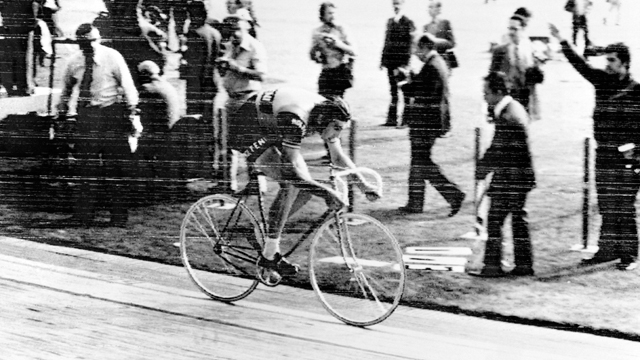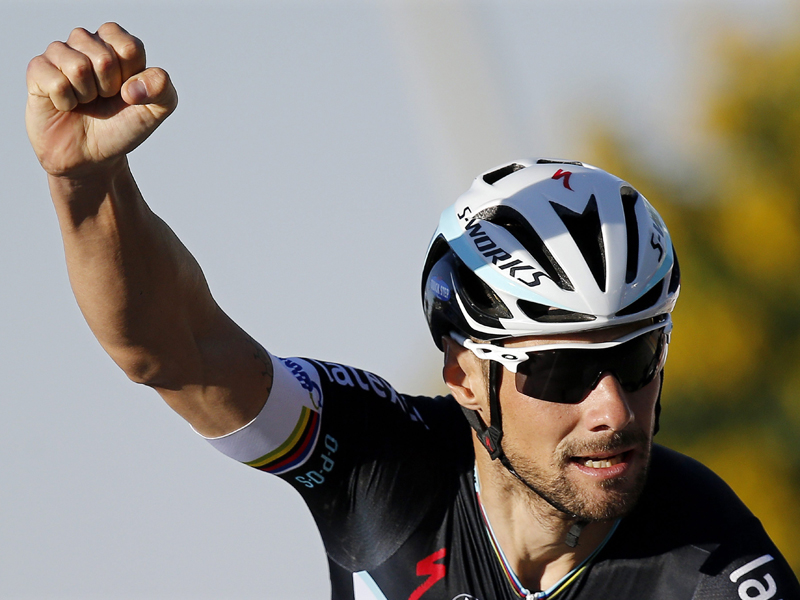The Koppenberg
600m long; 64m ascent; maximum gradient 22 per cent; average gradient 11.6 per cent. First used in 1976.
The super-steep, super-narrow Koppenberg might be Flanders’ most iconic climb, but it has rarely been the site of a race-winning attack. Even so, the road – little more than a cobbled goat track – has regularly been the location where many a hope for victory has ended through poor positioning or simple bad luck.
The most famous incident happened to Danish rider Jesper Skibby in 1987, whose bike was hit, then run over, by the race director’s car on the climb. This saw the road removed from the race until 2004.
However, the most decisive incident in terms of race results took place on the 1977 edition - and also sparked one of cycling’s most enduring feuds. Race favourite Freddy Maertens punctured on the Koppenberg, and was given a wheel (plus a push) by a spectator. This assistance was deemed to be illegal - despite the incidence being caused by the race director - and Maertens was disqualified. However, he continued to ride - eventually catching and towing rival Roger de Vlaeminck the remaining 70km to the finish line. De Vlaeminck won the sprint to take his only Tour of Flanders win, although many believe Maertens to be the ‘spiritual’ winner of the race.
The resulting disagreement over what actually happened between the two riders has lasted to this day. Maertens says that he knew he would be disqualified for his illegal wheel-change (it turns out he would have been disqualified for a doping positive anyway), but De Vlaeminck had offered him 300,000 francs to keep riding. De Vlaeminck insists that he made a tactical decision to stay on Maertens' wheel. Who is telling the truth? The only people who know that are the two riders themselves - and they’re sticking to their stories.
The Oude Kwaremont
2,200m long; 93m ascent. Maximum gradient 11 per cent; average gradient 4.2 per cent. First used in 1974.
At just 4.2 per cent average gradient, the Oude Kwaremont is far from the Ronde’s steepest climb; however, it is one of the race’s longest and most attritional efforts. The transition from asphalt to cobbles after 600m does an excellent job of whittling down the peloton. This is especially true in the race’s current format, where the Oude Kwaremont is climbed three times - the final time just 16km from the finish when the pace is truly on.
However, the most daring attack on the Oude Kwaremont came back in 1975, when the climb featured 104km from the finish. Eddy Merckx attacked with fellow Belgian Frans Verbeeck on the Kwaremont. The two held the peloton at bay for nearly 100km until Merckx, as was his wont, attacked with 6km to go and soloed to his second and final Flanders victory.

Merckx in his pomp Source: Getty Images
The Bosberg
986m long; 40m ascent; maximum gradient 11 per cent; average gradient 5.8 per cent. First used in 1975.
The first of two climbs in this list which no longer feature in the race - at least for now - the Bosberg was for many years the final climb before the run-in to the finish at Meerbeke. Rarely a decisive climb - either reinforcing the dominance of a rider who had attacked on the Kapelmuur or creating a final selection from which the final bunch sprint would be contested, the Bosberg has been the launchpad for many a doomed last-ditch attack - and who doesn’t love those?
Even so, the climb had days of glory when Belgian rouleur Edwin van Hooydonck – the inventor of the three-quarter length bib short - used it as a launchpad to solo victory in 1989 and 1991.
Those races were also watched by a young Tom Boonen, who attempted to repeat van Hooydonck’s feat on the way to his maiden victory in 2005. While Boonen’s escape was unsuccessful, he followed it up with an counter-attack on Peter van Petegem to solo into the finish - a result that Boonen repeated in the World Champion’s jersey in 2006 and again in 2012. Could we see Tornado Tom take a historic fourth victory in 2016?

Belgium's Tom Boonen is seeking a historic fourth Tour of Flanders victory, but does he still have the punch? Source: AAP
The Muur van Geraardsbergen/Kapelmuur
1,075m in length; 77m ascent; maximum gradient 20 per cent; average gradient 9.3 per cent. First used in 1950.
The Muur van Geraardsbergen or Kapelmuur is climb number two that’s absent in the current route, but this omission is the one that really rankles with Flanders purists – not least because the Muur is one of the hardest, most strategically important and picturesque climbs in the race.
A twisting ascent through the town of Geraardsbergen, the climb summits in front of the town chapel or Kapel (hence Kapelmuur). Its difficulty and proximity to the former race finish in Meerbeke made it the decisive climb from 1988 to 2012 – and one upon which legends are made.
Indeed, it was an attack on the Muur in 1969 that finally netted Eddy Merckx his first Ronde following several years of bad luck and near misses, as he relates in the following video for Belgian TV.
Three-time winner and eight-time podium attendee Johan Museeuw (aka The Lion of Flanders), also took his second victory in 1995 following a savage attack on the upper slopes of the Muur.
The most memorable attack on the Muur in recent years, however, was that of Fabian Cancellara in 2010. The sheer power of the then-Saxo Bank rider left Tom Boonen turning squares - a gap which Cancellara only widened as he time-trailed his way to the finish line. It’s also notable as the attack which first made observers wonder if a motor could be installed in a bike… judge for yourself.
The Paterberg
400m in length; 40m ascent. Maximum gradient 20 per cent; average gradient 12.5%. First climbed 1986
Last but certainly not least, the Paterberg is a relatively recent inclusion in the ranks of race-deciding climbs. First positioned as the final berg when the course was controversially revised in 2012, it played a critical role in Tom Boonen’s third - and to date final - victory when a crash on the penultimate lap saw an elite group get away - setting the stage for an electrifying game of cat-and-mouse into the finish.
Then, in 2013, Fabian Cancellara used its steep slopes to repeated his 2010 Muur tactic - only with Peter Sagan playing the role of second place man this time.
There’s little doubt that the Paterberg could play a critical role in deciding the winner of this year’s Tour of Flanders - especially with all the big-name favourites entering the race in good form and healthy (including Boonen, Cancellara and Sagan).
However, the joy of the Tour of Flanders is that the winning move can come at any point: whether on one of these iconic climbs, whether on another berg such as the Taaienberg or the Valkenberg, or even on the harsh Belgian roads linking the steep cobbled inclines. That unpredictability what makes this race one of the crown jewels of the cycling calendar – and a must-watch for any cycling fan.


